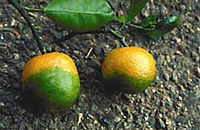
Photo from wikipedia
Asian citrus psyllid Diaphorina citri Kuwayama is an important economic pest of citrus, as it transmits Candidatus Liberibacter asiaticus, the causative agent of huanglongbing. In this study, we used RNA-seq… Click to show full abstract
Asian citrus psyllid Diaphorina citri Kuwayama is an important economic pest of citrus, as it transmits Candidatus Liberibacter asiaticus, the causative agent of huanglongbing. In this study, we used RNA-seq to identify novel genes and provide the first high-resolution view of the of D. citri transcriptome throughout development. The transcriptomes of D. citri during eight developmental stages, including the egg, five instars, and male and female adults were sequenced. In total, 115 million clean reads were obtained and assembled into 354,726 unigenes with an average length of 925.65 bp and an N50 length of 1733 bp. Clusters of Orthologous Groups, Gene Ontology, and Kyoto Encyclopedia of Genes and Genomes analyses were conducted to functionally annotate the genes. Differential expression analysis highlighted developmental stage-specific expression patterns. Furthermore, two trehalase genes were characterized with lower expression in adults compared to that in the other stages. The RNA interference (RNAi)-mediated suppression of the two trehalase genes resulted in significantly high D. citri mortality. This study enriched the genomic information regarding D. citri. Importantly, these data represent the most comprehensive transcriptomic resource currently available for D. citri and will facilitate functional genomics studies of this notorious pest.
Journal Title: International Journal of Molecular Sciences
Year Published: 2020
Link to full text (if available)
Share on Social Media: Sign Up to like & get
recommendations!